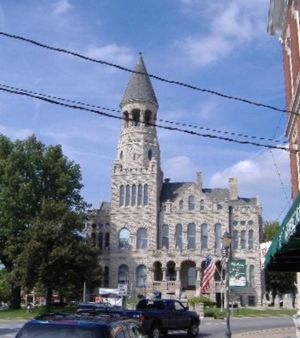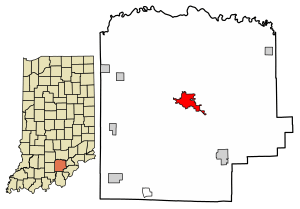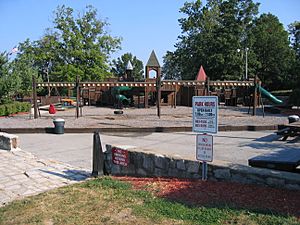Salem, Indiana facts for kids
Quick facts for kids
Salem, Indiana
|
|
|---|---|

Washington County Courthouse, in the town square
|
|

Location of Salem in Washington County, Indiana.
|
|
| Country | United States |
| State | Indiana |
| County | Washington |
| Township | Washington |
| Town founded | 1814 |
| Area | |
| • Total | 4.02 sq mi (10.40 km2) |
| • Land | 4.00 sq mi (10.36 km2) |
| • Water | 0.02 sq mi (0.04 km2) 0.50% |
| Elevation | 751 ft (229 m) |
| Population
(2020)
|
|
| • Total | 6,371 |
| • Density | 1,592.75/sq mi (615.02/km2) |
| Time zone | UTC-5 (EST) |
| • Summer (DST) | UTC-4 (EDT) |
| ZIP Code |
47167
|
| Area code(s) | 812 |
| FIPS code | 18-67464 |
| GNIS feature ID | 442876 |
| Website | http://cityofsalemin.com/ |
Salem is a city in and the county seat of Washington Township, Washington County, in the U.S. state of Indiana. The population was 6,319 at the 2010 census.
Contents
History
Salem was laid out and platted in 1814. It was named for Salem, North Carolina, the hometown of one of the city founders.
The Salem post office has been in operation since 1816.
Morgan's Raid
In June 1863, the Confederate cavalry under John Hunt Morgan had departed Tennessee on what would later become known as Morgan's Raid. Traveling through Tennessee and into Kentucky, Morgan eventually crossed into Indiana; he reached Salem on July 10, 1863, coming north from Corydon. Upon entering Salem at approximately 9 a.m., Morgan immediately took possession of the town and placed guards over the stores and streets. The cavalrymen burned the large, brick railroad depot, along with all the train cars on the track and the railroad bridges on each side of the town. Morgan demanded taxes from the two flour mills that belonged to DePauw and Knight, and from the Allen Wollen Mill. Morgan's men looted stores and took about $500 from the area before departing about 3 p.m.
Of the brief action at Salem, Col. Basil W. Duke, Morgan's second-in-command and brother-in-law, later said:
"They did not pillage with any sort of method or reason; it seemed to be a mania, senseless and purposeless. One man carried for two days a bird cage containing three canaries. Another rode with a huge chafing dish on the pommel of his saddle. Although the weather was intensely warm, another slung seven pairs of skates around his neck. I saw very few articles of real value taken; they pillaged like boys robbing an orchard."
Geography
Salem is primarily an agricultural community, surrounded by typical Indiana forests and farmland and small bodies of water. The primary crops grown in the area are corn and soybeans. Homes in the area are of a variety of styles, with a portion of residential homes having Victorian architectural design.
According to the 2010 census, Salem has a total area of 4.018 square miles (10.41 km2), of which 4 square miles (10.36 km2) (or 99.55%) is land and 0.018 square miles (0.05 km2) (or 0.45%) is water.
Climate
The climate in this area is characterized by hot, humid summers and generally mild to cool winters. According to the Köppen Climate Classification system, Salem has a humid subtropical climate, abbreviated "Cfa" on climate maps.
Demographics
| Historical population | |||
|---|---|---|---|
| Census | Pop. | %± | |
| 1850 | 1,223 | — | |
| 1860 | 1,372 | 12.2% | |
| 1870 | 1,294 | −5.7% | |
| 1880 | 1,615 | 24.8% | |
| 1890 | 1,974 | 22.2% | |
| 1900 | 1,995 | 1.1% | |
| 1910 | 2,283 | 14.4% | |
| 1920 | 2,836 | 24.2% | |
| 1930 | 3,194 | 12.6% | |
| 1940 | 3,194 | 0.0% | |
| 1950 | 3,271 | 2.4% | |
| 1960 | 4,546 | 39.0% | |
| 1970 | 5,041 | 10.9% | |
| 1980 | 5,290 | 4.9% | |
| 1990 | 5,619 | 6.2% | |
| 2000 | 6,172 | 9.8% | |
| 2010 | 6,319 | 2.4% | |
| 2020 | 6,371 | 0.8% | |
| U.S. Decennial Census | |||
As of 2000 the median income for a household in the city was $29,256, and the median income for a family was $37,179. Males had a median income of $27,521 versus $21,952 for females. The per capita income for the city was $16,299. About 8.5% of families and 11.6% of the population were below the poverty line, including 14.6% of those under age 18 and 5.7% of those age 65 or over.
2010 census
As of the census of 2010, there were 6,319 people, 2,622 households, and 1,599 families residing in the city. The population density was 1,579.8 inhabitants per square mile (610.0/km2). There were 2,932 housing units at an average density of 733.0 per square mile (283.0/km2). The racial makeup of the city was 97.5% White, 0.4% African American, 0.3% Native American, 0.6% Asian, 0.3% from other races, and 0.9% from two or more races. Hispanic or Latino of any race were 1.0% of the population.
There were 2,622 households, of which 32.6% had children under the age of 18 living with them, 39.2% were married couples living together, 15.3% had a female householder with no husband present, 6.4% had a male householder with no wife present, and 39.0% were non-families. 33.8% of all households were made up of individuals, and 14.9% had someone living alone who was 65 years of age or older. The average household size was 2.31 and the average family size was 2.91.
The median age in the city was 38.3 years. 24% of residents were under the age of 18; 8.6% were between the ages of 18 and 24; 25.6% were from 25 to 44; 24.2% were from 45 to 64; and 17.6% were 65 years of age or older. The gender makeup of the city was 46.5% male and 53.5% female.
Arts and culture
Annual cultural events
Every September, Salem celebrates "Old Settler's Day" at the John Hay Center. Set in a village of authentic log structures, the festival features historical re-enactments, as well as local arts and crafts. Along with "Old Settler's Day", Salem also celebrates Friday Night on the Square in September. The town square is barricaded from cars and the people of Salem meet to enjoy the festivities which include food booths, commercial booths and sometimes even scavenger hunts.
Museums and other points of interest
The downtown area is on the National Register of Historic Places, as are several local buildings.
The Carnegie Library in Salem was one of nearly 2,000 libraries built in the United States including 164 in Indiana in the early 20th century with funds donated by steel conglomerate Andrew Carnegie. Salem received the grant in February 1904, broke ground in August 1904 and opened in July 1905. Still in use today, the Carnegie Library in Salem is one of just one hundred in the state of Indiana still being used for its original purpose.
Located in the center of Salem's town square, the Washington County Courthouse is generally known as Salem's most famous and recognizable landmark. The courthouse has historical place markers surrounding it, and at the southeastern corner of the grounds, there is a memorial to veterans killed in action during conflicts dating back to the Revolutionary War.
The birthplace of John Hay has been a National Historic Site since 1971 and is located in Salem. The building was originally used as a school house and was built in 1824. It has been restored and furnished in the 1840 period.
Parks and recreation
Unusual for a town of this size is a large children's playground, "Riley's Place" at DePauw Park. Named after Riley Jean Tomlinson, a local toddler who accidentally drowned in a swimming pool, the park was built in 2001 and contains two- and three- story wooden castles and other structures for children's play (along with swings, slides, and similar playground equipment).
1988 bomb scare
On July 5, 1988, 13 homemade bombs placed inside brown grocery bags were discovered near bridges and buildings around the town containing sticks of dynamite. However, due to faulty blasting caps, none of the bombs exploded. Had the explosives gone off, it would have severed the town from outside aid.
Two men, John M. Hubbard and Jerry A. Conrad were convicted on all counts in September and October 1989. Prosecutors allege that Mr. Hubbard had a long-standing rivalry with Democratic State Representative Frank Newkirk Jr..
- Indiana Historical Commission. Archaeological and Historical Survey of Washington County (August 1924). Wm. B. Burford
Sports
Salem is also home to Salem Speedway. It is a half mile high banked paved oval that was first built in 1947. Many of the most legendary drivers of the past 50 years have raced there including Ted Horn, Parnelli Jones, AJ Foyt, Bobby and Al Unser, Mario Andretti, Larry Dickson, Darrell Waltrip and Jeff Gordon. AJ Foyt at one time held the world record for a half mile oval at the speedway. One of ESPN's first televised auto racing events was held there in 1979.
Notable people
- Newton Booth, Governor of California and U.S. Senator there during the 19th Century, was born in Salem.
- Edgar D. Bush, Lieutenant Governor Of Indiana, lived in Salem.
- Arthur A. Denny, one of the founders of Seattle, Washington, was born 20 June 1822 in Salem, Indiana.
- Washington C. DePauw, successful businessman whom DePauw University is named after. DePauw donated a large portion of his wealth shortly before his death to the now defunct Indiana Asbury University who renamed their school in his honor in January 1884. DePauw was born in Salem.
- Flora Harrod Hawes, youngest woman postmaster in the US; born in Salem.
- John Hay, private secretary to President Abraham Lincoln and Secretary of State to Presidents William McKinley and Theodore Roosevelt, was born in Salem and is generally known as Salem's most prominent citizen. A variety of museums and local buildings make reference to Mr. Hay's connections to the town.
- Robert H. Milroy, general in the Union Army during the Civil War, born in Salem.
- John Pickler, member of the United States House of Representatives; born in Salem.
- Roy Robertson, the creator of 2% milk, also seen and known as the "Blue cap" milk in the US.
See also
 In Spanish: Salem (Indiana) para niños
In Spanish: Salem (Indiana) para niños


